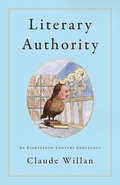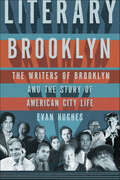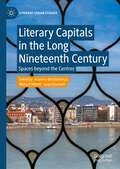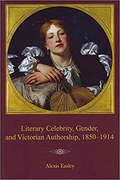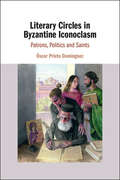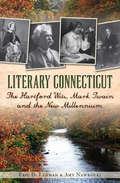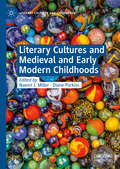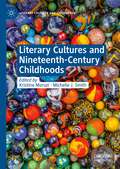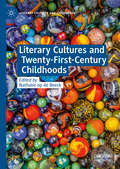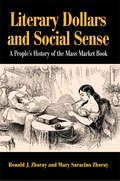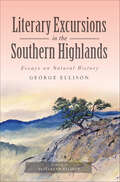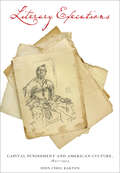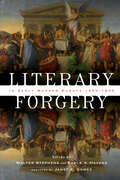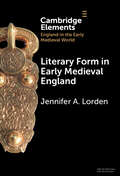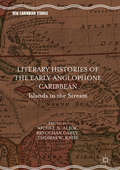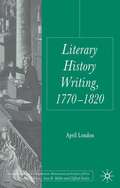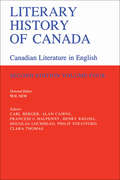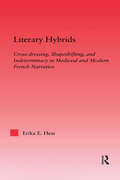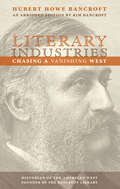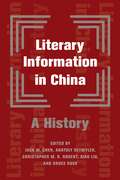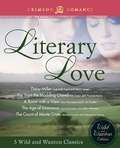- Table View
- List View
Literary Authority: An Eighteenth-Century Genealogy
by Claude WillanThis book is the cultural history of an idea which now seems so self-evident as barely to be worth stating: through writing imaginative literature, an author can accrue significant and lasting economic and cultural power. We take for granted, now, that authority dwells in literature and in being its author. This state of affairs was not naturally occurring, but deliberately invented. This book tells the story of that invention. The story's central figures are Alexander Pope and Samuel Johnson. But its narrative begins in the 1680s, with the last gasp of the bond linking literary to political authority. While Jacobite poets celebrated (and mourned) the Stuart dynasty, Whig writers traced the philosophical and aesthetic consequences of the accession of William of Orange. Both groups left behind sets of literary devices ready-made to confer and validate authority. Claude Willan challenges the continued reign of the "Scriblerian" model of the period and shows how that reign was engineered. In so doing he historicizes the relationship between "good" and "bad" writing, and suggests how we might think about literature and beauty had Pope and Johnson not taken literary authority for themselves. What might literature have looked like, and what could we use it for, he provocatively asks.
Literary Brooklyn: The Writers of Brooklyn and the Story of American City Life
by Evan HughesFor the first time, here is Brooklyn's story through the eyes of its greatest storytellers—Walt Whitman, Henry Miller, Truman Capote, Paula Fox, and others.Like Paris in the twenties or postwar Greenwich Village, Brooklyn today is experiencing an extraordinary cultural boom. In recent years, writers of all stripes—from Jhumpa Lahiri, Jennifer Egan, and Colson Whitehead to Nicole Krauss and Jonathan Safran Foer—have flocked to its patchwork of distinctive neighborhoods. But as literary critic and journalist Evan Hughes reveals, the rich literary life now flourishing in Brooklyn is part of a larger, fascinating history. With a dynamic mix of literary biography and urban history, Hughes takes us on a tour of Brooklyn past and present and reveals that hiding in Walt Whitman's Fort Greene Park, Hart Crane's Brooklyn Bridge, the raw Williamsburg of Henry Miller's youth, Truman Capote's famed house on Willow Street, and the contested streets of Jonathan Lethem's Boerum Hill is the story of more than a century of life in America's cities.Literary Brooklyn is a prismatic investigation into a rich literary inheritance, but most of all it's a deep look into the beloved borough, a place as diverse and captivating as the people who walk its streets and write its stories.“In a way, the literary history of Brooklyn is like a literary history of America itself—not because America is like Brooklyn, which it isn't, but because it is a story of a certain set of writers describing what they knew as America came into being, as the country invented a literature of its own.” ―Los Angeles Times“An engrossing cultural memoir.” ―New York Daily News
Literary Capitals in the Long Nineteenth Century: Spaces beyond the Centres (Literary Urban Studies)
by Richard Hibbitt Arunima Bhattacharya Laura ScuriattiThis book develops our understanding of the global literary field in the long nineteenth century by discussing nine different places outside the established metropoles. It shows how different economic, geographical and political factors combined to give each place its own distinctive literary culture and symbolic capital. Taking a geocritical approach, the book shows how its different case studies can be seen as ‘literary capitals’ in terms of their role within the wider nation, region or empire. The volume is divided into three parts. Part One discusses Kolkata, Hong Kong and Buenos Aires. Part Two considers ‘semi-peripheral’ European cities: Pest-Buda (Budapest), Helsinki and Dublin. Part Three focuses on cities within Italy: Trieste, Florence and Rome. Drawing on a wide range of literary texts and different genres, the book reads the nineteenth-century literary field as a constellation where different connections can be plotted across various points on the map at different times.
Literary Celebrity, Gender, and Victorian Authorship, 1850-1914
by Alexis EasleyThis study examines literary celebrity in Britain from 1850 to 1914. Through lively analysis of rare cultural materials, Easley demonstrates the crucial role of the celebrity author in the formation of British national identity. As Victorians toured the homes and haunts of famous writers, they developed a sense of shared national heritage. At the same time, by reading sensational accounts of writers’ lives, they were able to reconsider conventional gender roles and domestic arrangements. As women were featured in interviews and profiles, they were increasingly associated with the ephemerality of the popular press and were often excluded from emerging narratives of British literary history, which defined great literature as having a timeless appeal. Nevertheless, women writers were able to capitalize on celebrity media as a way of furthering their own careers and retelling history on their own terms. Press attention had a more positive effect on men’s literary careers since they were expected to assume public identities; however, in some cases, media exposure had the effect of sensationalizing their lives, bodies, and careers. With the development of proto-feminist criticism and historiography, the life stories of male writers were increasingly used to expose unhealthy domestic relationships and imagine ideal forms of British masculinity. The first section of Literary Celebrity explores the practice of literary tourism in Victorian Britain, focusing specifically on the homes and haunts of Charles Dickens, Christina Rossetti, George Eliot, Elizabeth Barrett Browning, and Harriet Martineau. This investigation incorporates analysis of fascinating cultural texts, including maps, periodicals, and tourist guidebooks. Easley links the practice of literary tourism to a variety of cultural developments, including nationalism, urbanization, spiritualism, the women’s movement, and the expansion of popular print culture. The second section provides fresh insight into the ways that celebrity culture informed the development of Victorian historiography. Easley demonstrates how women were able to re-tell history from a proto-feminist perspective by writing contemporary history, participating in architectural reform movements, and becoming active in literary societies. In this chapter she returns to the work of Harriet Martineau and introduces a variety of lesser-known contributors to the field, including Mary Gillies and Mary Ward. Literary Celebrity concludes with a third section focused on the expansion of celebrity media at the fin de siècle. These chapters and a brief coda link the popularization of celebrity news to the de-canonization of women writers, the professionalization of medicine, the development of the open space movement, and the institutionalization of English studies. These investigations elucidate the role of celebrity media in the careers of Charlotte Robinson, Marie Corelli, Mary Braddon, Harriet Martineau, Thomas Carlyle, Ernest Hart, and Octavia Hill. Published by University of Delaware Press. Distributed worldwide by Rutgers University Press.
Literary Circles in Byzantine Iconoclasm: Patrons, Politics and Saints
by Óscar Prieto DomínguezIconoclasm was the name given to the stance of that portion of Eastern Christianity that rejected worshipping God through images (eikones) representing Christ, the Virgin or the saints and was the official doctrine of the Byzantine Empire for most of the period between 726 and 843. It was a period marked by violent passions on either side. This is the first comprehensive account of the extant contemporary texts relating to this phenomenon and their impact on society, politics and identity. By examining the literary circles emerging both during the time of persecution and immediately after the restoration of icons in 843, the volume casts new light on the striking (re)construction of Byzantine society, whose iconophile identity was biasedly redefined by the political parties led by Theodoros Stoudites, Gregorios Dekapolites and Empress Theodora or the patriarchs Methodios, Ignatios and Photios. It thereby offers an innovative paradigm for approaching Byzantine literature.
Literary Connecticut: The Hartford Wits, Mark Twain and the New Millennium
by Eric D. Lehman Amy NawrockiFrom the father of American English to the most famous novelist in America, Connecticut has produced and inspired a dazzling array of literary talent. Discover the secret passage to James Merrill's study in Stonington or navigate Hartford's Nook Farm neighborhood--a home and hub of inspiration to Harriet Beecher Stowe, Mark Twain and William Gillette. As an adult, Helen Keller's stomping grounds were the woods and gardens of Easton, while Eugene O'Neill's childhood home in New London found its way into the pages of his greatest work. These authors drove the same roads, frequented the same taverns and read the same books as the nutmeggers of today. Explore Connecticut's literary landscape with Eric D. Lehman and Amy Nawrocki as they introduce readers to some of the greatest writers who found a home in the Constitution State.
Literary Cultures and Medieval and Early Modern Childhoods (Literary Cultures and Childhoods)
by Naomi J. Miller Diane PurkissBuilding on recent critical work, this volume offers a comprehensive consideration of the nature and forms of medieval and early modern childhoods, viewed through literary cultures. Its five groups of thematic essays range across a spectrum of disciplines, periods, and locations, from cultural anthropology and folklore to performance studies and the history of science, and from Anglo-Saxon burial sites to colonial America. Contributors include several renowned writers for children. The opening group of essays, Educating Children, explores what is perhaps the most powerful social engine for the shaping of a child. Performing Childhood addresses children at work and the role of play in the development of social imitation and learning. Literatures of Childhood examines texts written for children that reveal alternative conceptions of parent/child relations. In Legacies of Childhood, expressions of grief at the loss of a child offer a window into the family’s conceptions and values. Finally, Fictionalizing Literary Cultures for Children considers the real, material child versus the fantasy of the child as a subject.
Literary Cultures and Nineteenth-Century Childhoods (Literary Cultures and Childhoods)
by Kristine Moruzi Michelle J. SmithLiterary Cultures and Nineteenth-Century Childhoods explores the construction of the child and the development of texts for children in the nineteenth century through the application of fresh theoretical approaches and attention to aspects of literary childhoods that have only recently begun to be illuminated. This scope enables examination of the child in canonical nineteenth-century novels by Charles Dickens, Elizabeth Gaskell, Charlotte Bronte, and Thomas Hardy alongside well-known fiction intended for young readers by George MacDonald, Christabel Coleridge, and Kate Greenaway. The century was also distinctive for the rise of the children’s magazine, and this book broadens the definition of literary cultures to include magazines produced both by, and for, young people. The volume examines how the child and family are conceptualised, how children are positioned as readers in genres including the domestic novel, school story, Robinsonade, and fantasy fiction, how literary childhoods are written and politicised, and how childhood intersects with perceptions of animals and the natural environment. The range of chapters in this collection and the texts they consider demonstrates the variability and fluidity of literary cultures and nineteenth-century childhoods.
Literary Cultures and Twenty-First-Century Childhoods (Literary Cultures and Childhoods)
by Nathalie op de BeeckIn the early decades of the twenty-first century, we are grappling with the legaciesof past centuries and their cascading effects upon children and all people. Werealize anew how imperialism, globalization, industrialization, and revolutioncontinue to reshape our world and that of new generations. At a volatile moment,this collection asks how twenty-first century literature and related mediarepresent and shape the contemporary child, childhood, and youth.Because literary representations construct ideal childhoods as well as model therights, privileges, and respect afforded to actual young people, this collectionsurveys examples from popular culture and from scholarly practice. Chaptersinvestigate the human rights of children in literature and international policy; thepotential subjective agency and power of the child; the role models proposed foryoung people; the diverse identities children embody and encounter; and theenvironmental well-being of future human and nonhuman generations.As a snapshot of our developing historical moment, this collection identifiesemergent trends, considers theories and critiques of childhood and literature,and observes how new technologies and paradigms are destabilizing pastconventions of storytelling and lived experience.
Literary Dollars and Social Sense: A People's History of the Mass Market Book
by Ronald J. Zboray Mary Saracino ZborayPrior to the Civil War, publishing in America underwent a transformation from a genteel artisan trade supported by civic patronage and religious groups to a thriving, cut-throat national industry propelled by profit. Literary Dollars and Social Sense represents an important chapter in the historical experience of print culture, it illuminates the phenomenon of amateur writing and delineates the access points of the emerging mass market for print for distributors consumers and writers. It challenges the conventional assumptions that the literary public had little trouble embracing the new literary marketing that emerged at mid-century. The book uncover the tensions that author's faced between literature's role in the traditional moral economy and the lure of literary dollars for personal gain and fame. This book marks an important example in how scholars understand and conduct research in American literature.
Literary Excursions in the Southern Highlands: Essays on Natural History (Natural History)
by George EllisonExtending from Roanoke to Mount Oglethorpe and bounded by the Appalachian Mountains, the Southern Highlands is one of the most diverse natural areas in North America. From beautiful flora like the Fraser magnolia to rare ecosystems such as the mountain cedar glades, the area has been an inspiration for writers and naturalists since it was first explored by William Bartram in 1775. Investigate the biology of the cloudless sulphur butterfly, whose erratic flight is used to confuse its prey. Discover the botany of the white ash tree, said to produce the most satisfying crack of a baseball bat. Essayist, poet and naturalist George Ellison explores the abundant wonders of the Southern Highlands in a series of humorous, scientific and literary essays vividly illustrated by artist Elizabeth Ellison.
Literary Executions: Capital Punishment and American Culture, 1820–1925
by John Cyril BartonExamines literary and legal sources to document thoughts and feelings about capital punishment in the United States over the long nineteenth century.Drawing from legal and extralegal discourse but focusing on imaginative literature, Literary Executions examines representations of, responses to, and arguments for and against the death penalty in the United States over the long nineteenth century. John Cyril Barton creates a generative dialogue between artistic relics and legal history. He looks to novels, short stories, poems, and creative nonfiction as well as legislative reports, trial transcripts, legal documents, newspaper and journal articles, treatises, and popular books (like The Record of Crimes, A Defence of Capital Punishment, and The Gallows, the Prison, and the Poor House), all of which were part of the debate over the death penalty.Barton focuses on several canonical figures—James Fenimore Cooper, Nathaniel Hawthorne, Lydia Maria Child, Walt Whitman, Herman Melville, and Theodore Dreiser—and offers new readings of their work in light of the death penalty controversy. Barton also gives close attention to a host of then-popular-but-now-forgotten writers—particularly John Neal, Slidell MacKenzie, William Gilmore Simms, Sylvester Judd, and George Lippard—whose work helped shape or was shaped by the influential anti-gallows movement. Analyzing the tension between sovereignty and social responsibility in a democratic republic, Barton argues that the high stakes of capital punishment dramatize the confrontation between the citizen-subject and sovereign authority in its starkest terms. In bringing together the social and the aesthetic, Barton shows how legal forms informed literary forms and traces the emergence of the modern State in terms of the administration of lawful death.By engaging the politics and poetics of capital punishment, Literary Executions contends that the movement to abolish the death penalty in the United States should be seen as an important part of the context that brought about the flowering of the American Renaissance during the antebellum period and that influenced literature later in the nineteenth and early twentieth centuries.
Literary Executions: Capital Punishment and American Culture, 1820–1925
by John Cyril Barton“Rich with historical detail . . . examines the figure and theme of the death penalty in imaginative literature from Cooper to Dreiser.” —Gregg Crane, Professor of English Language and Literature, University of MichiganDrawing from legal and extralegal discourse but focusing on imaginative literature, Literary Executions examines representations of, responses to, and arguments for and against the death penalty in the United States over the long nineteenth century. John Cyril Barton creates a generative dialogue between artistic relics and legal history. He looks to novels, short stories, poems, and creative nonfiction as well as legislative reports, trial transcripts, legal documents, newspaper and journal articles, treatises, and popular books (like The Record of Crimes, A Defence of Capital Punishment, and The Gallows, the Prison, and the Poor House), all of which were part of the debate over the death penalty.Barton focuses on several canonical figures—James Fenimore Cooper, Nathaniel Hawthorne, Lydia Maria Child, Walt Whitman, Herman Melville, and Theodore Dreiser—and offers new readings of their work in light of the death penalty controversy. Barton also gives close attention to a host of then-popular-but-now-forgotten writers—particularly John Neal, Slidell MacKenzie, William Gilmore Simms, Sylvester Judd, and George Lippard—whose work helped shape or was shaped by the influential anti-gallows movement.By engaging the politics and poetics of capital punishment, Literary Executions contends that the movement to abolish the death penalty in the United States should be seen as an important part of the context that brought about the flowering of the American Renaissance during the antebellum period and that influenced literature later in the nineteenth and early twentieth centuries
Literary Forgery in Early Modern Europe, 1450–1800
by Janet E Gomez“The essays gathered in this volume demonstrate that studying early modern European literary forgeries is a fascinating cultural adventure” (Lina Bolzoni author of The Gallery of Memory).This comprehensive study of literary and historiographical forgery goes well beyond questions of authorship. It spotlights the imaginative vitality of forgery and its sinister impact on genuine scholarship. This volume demonstrates that early modern forgery was a literary tradition in its own right, with distinctive connections to politics, Greek and Roman classics, religion, philosophy, and modern literature. The early modern explosion in forgery of all kinds—particularly in the fields of literary and archaeological falsification—demonstrates a dramatic shift in attitudes toward historical evidence and in the relation of texts to contemporary society. The authors capture the impact of this evolution within many cultural transformations, including the rise of print, changing tastes and fortunes of the literary marketplace, and the Protestant and Catholic Reformations.The thirteen essays draw on Johns Hopkins University’s Bibliotheca Fictiva, the world’s premier research collection dedicated exclusively to the subject of literary forgery. It consists of several thousand rare books and unique manuscript materials from the early modern period and beyond.Contributors: Frederic Clark, James Coleman, Richard Cooper, Arthur Freeman, Anthony Grafton, A. Katie Harris, Earle A. Havens, Jack Lynch, Shana D. O’Connell, Ingrid Rowland, Walter Stephens, Elly Truitt, Kate Tunstall
Literary Forgery in Early Modern Europe, 1450–1800
by Walter Stephens; Earle A. Havens; Janet E. GomezWhy was the Renaissance also the golden age of forgery?Forgery is an eternal problem. In literature and the writing of history, suspiciously attributed texts can be uniquely revealing when subjected to a nuanced critique. False and spurious writings impinge on social and political realities to a degree rarely confronted by the biographical criticism of yesteryear. They deserve a more critical reading of the sort far more often bestowed on canonical works of poetry and prose fiction. The first comprehensive treatment of literary and historiographical forgery to appear in a quarter of a century, Literary Forgery in Early Modern Europe, 1450–1800 goes well beyond questions of authorship, spotlighting the imaginative vitality of forgery and its sinister impact on genuine scholarship. This volume demonstrates that early modern forgery was a literary tradition in its own right, with distinctive connections to politics, Greek and Roman classics, religion, philosophy, and modern literature. The thirteen essays draw immediate inspiration from Johns Hopkins University’s acquisition of the Bibliotheca Fictiva, the world’s premier research collection dedicated exclusively to the subject of literary forgery, which consists of several thousand rare books and unique manuscript materials from the early modern period and beyond.The early modern explosion in forgery of all kinds—particularly in the kindred documentary fields of literary and archaeological falsification—was the most visible symptom of a dramatic shift in attitudes toward historical evidence and in the relation of texts to contemporary society. The authors capture the impact of this evolution within many fundamental cultural transformations, including the rise of print, changing tastes and fortunes of the literary marketplace, and the Protestant and Catholic Reformations.Contributors: Frederic Clark, James Coleman, Richard Cooper, Arthur Freeman, Anthony Grafton, A. Katie Harris, Earle A. Havens, Jack Lynch, Shana D. O’Connell, Ingrid Rowland, Walter Stephens, Elly Truitt, Kate Tunstall
Literary Form in Early Medieval England (Elements in England in the Early Medieval World)
by Jennifer A. LordenThe earliest English writers left little comment on their literary forms. In contrast to the grammatical treatises of late antiquity or critical studies of contemporary and modern literature, early medieval English writing offers only sparse contemporaneous self-commentary, often in brief or conventional notes along the way to other things. But Old English and Latin literature had lively and evolving practices of literary form and formal innovation. Literary Form in Early Medieval England examines both more and lesser known forms, considering the multilingual landscape of early medieval England and showing that Old English literary forms do not simply end with the rupture of the Norman Conquest but continue in surprising ways. Literary Form in Early Medieval England offers a concise tour of what we do know of literary forms, both those that have received more attention and those that have been relatively overlooked, across the first six centuries of English literature.
Literary Histories of the Early Anglophone Caribbean: Islands In The Stream (New Caribbean Studies)
by Brycchan Carey Nicole N. Aljoe Thomas W. KriseThe Caribbean has traditionally been understood as a region that did not develop a significant ‘native’ literary culture until the postcolonial period. Indeed, most literary histories of the Caribbean begin with the texts associated with the independence movements of the early twentieth century. However, as recent research has shown, although the printing press did not arrive in the Caribbean until 1718, the roots of Caribbean literary history predate its arrival. This collection contributes to this research by filling a significant gap in literary and historical knowledge with the first collection of essays specifically focused on the literatures of the early Caribbean before 1850.
Literary History Writing, 1770–1820
by April LondonThis investigation of literary history writing between 1770 and 1820 identifies the mode's distinction from canon formation as central to its cultural vitality. Using secret history, memoir and the novel, amongst other sources, it invites a re-thinking of literary history's place in late eighteenth and early nineteenth-century print culture.
Literary History of Canada: Canadian Literature in English, Volume IV (Second Edition)
by Alan Cairns Clara Thomas Carl Berger Douglas Lochhead William New Francess Halpenny Henry Kreisel Philip StratfordThis new volume of the Literary History of Canada covers the continuing development of English-Canadian writing from 1972 to 1984. As with the three earlier volumes, this book is an invaluable guide to recent developments in English-Canadian literature and a resource for both the general reader and the specialist researcher. The contributors to this volume are Laurie Ricou, David Jackel, Linda Hutcheon, Philip Stratford, Barry Cameron, Balachandra Rajan, Robert Fothergill, Brian Parker, Cynthia Zimmerman, Frances Frazer, Edith Fowke, Bruce G. Trigger, Alan C. Cairns, Douglas Williams, Carl Berger, Shirley Neuman, Raymond S. Corteen, and Francess G. Halpenny.
Literary Hybrids: Indeterminacy in Medieval & Modern French Narrative (Studies in Medieval History and Culture #Vol. 21)
by Erika E. HessFirst Published in 2004. Routledge is an imprint of Taylor & Francis, an informa company.
Literary Industries: Chasing a Vanishing West
by Hubert BancroftA bookseller in San Francisco during the gold rush, Hubert Howe Bancroft (1832-1918) rose to become the man who would define the early history of California and the West. Creating what he called a “history factory,” he assembled a vast library of over sixty thousand books, maps, letters, and documents; hired scribes to copy material in private hands; employed interviewers to capture the memories of early Spanish and Mexican settlers; and published multiple volumes sold throughout the country by his subscription agents. In 1890 he published an eight-hundred-page autobiography, aptly entitled Literary Industries. Literary Industries sparkles with the exuberance of nineteenth-century California and introduces us to a man of great complexity and wit. Edited for the modern reader and yet relating the history of the West as it was taking place--and as it was being recorded--Kim Bancroft’s edition of Literary Industries is a joy to read.
Literary Industries: Chasing a Vanishing West
by Hubert Howe BancroftAn autobiography of the bookseller, library collector, man of letters, and historian of the American West edited by his great-great granddaughter. A bookseller in San Francisco during the gold rush, Hubert Howe Bancroft (1832–1918) rose to become the man who would define the early history of California and the West. Creating what he called a &“history factory,&” he assembled a vast library of over sixty thousand books, maps, letters, and documents; hired scribes to copy material in private hands; employed interviewers to capture the memories of early Spanish and Mexican settlers; and published multiple volumes sold throughout the country by his subscription agents. In 1890 he published an eight-hundred-page autobiography, aptly entitled Literary Industries. Literary Industries sparkles with the exuberance of nineteenth-century California and introduces us to a man of great complexity and wit. Edited for the modern reader and yet relating the history of the West as it was taking place—and as it was being recorded—Kim Bancroft&’s edition of Literary Industries is a joy to read.
Literary Information in China: A History
by Chen, Jack W.; Detwyler, Anatoly; Liu, Xiao; M. B. Nugent, Christopher; Rusk, Bruce“Information” has become a core concept across the disciplines, yet it is still often seen as a unique feature of the Western world that became central only in the digital age. In this book, leading experts turn to China’s textual tradition to show the significance of information for reconceptualizing the work of literary history, from its beginnings to the present moment.Contributors trace the organization of literary information across China’s three millennia of history, examining the forms and practices of information management that have evolved alongside the increasing scale and complexity of textual production. They reimagine literary history as information processing, detailing the many kinds of storage, encoding, sorting, and transmission that constitute and feed back into China’s long and ever-growing cultural tradition. The volume features state-of-the-field essays on all major forms of literary information management, from graphs to internet literature, and from commentaries to literary museums and archives. By shifting focus from individual works and their authors to the informatic schemata of literature, it identifies three scales of information management—the word, the document, and the collection—and surveys the forms that operate at each level, such as the dictionary, the anthology, and the library.Literary Information in China is a groundbreaking work that provides a systematic and innovative reassessment of literary history with implications that extend beyond the particular Chinese context, revealing how informatic practices shape literary tradition.
Literary Love: 5 Wild and Wanton Classics
by Henry James Alexandre Dumas Edith Wharton Thomas Hardy E. M. Forster Pan Zador Monica Corwin Gabrielle Vigot Coco RousseauClassic literature has never been so sexy! With some modern sensuality sprinkled into these vaunted literary classics, reading the canon is more delectable than ever. This value-priced digital collection includes spiced-up editions of:Daisy Miller by Gabrielle Vigot & Henry JamesFar from the Madding Crowd by Pan Zador & Thomas HardyA Room with a View by Coco Rousseau & E. M. ForsterThe Age of Innocence by Coco Rousseau & Edith WhartonThe Count of Monte Cristo by Monica Corwin & Alexandre Dumas.Sensuality Level: Sensual
Literary Love: 5 Wild and Wanton Classics
by Henry James Alexandre Dumas Edith Wharton Thomas Hardy E. M. Forster Pan Zador Monica Corwin Gabrielle Vigot Coco RousseauClassic literature has never been so sexy! With some modern sensuality sprinkled into these vaunted literary classics, reading the canon is more delectable than ever. This value-priced digital collection includes spiced-up editions of:Daisy Miller by Gabrielle Vigot & Henry JamesFar from the Madding Crowd by Pan Zador & Thomas HardyA Room with a View by Coco Rousseau & E. M. ForsterThe Age of Innocence by Coco Rousseau & Edith WhartonThe Count of Monte Cristo by Monica Corwin & Alexandre Dumas.Sensuality Level: Sensual
